Examples of How Jesus Has Been Pictured Throughout History
Jesus Throughout History
Throughout history, Jesus has been represented in many different ways. Artists often rely on their cultural or religious backgrounds and current events to depict Jesus in a relevant way. Each representation of Jesus can give us an insight into the meaning of his life, death, and Resurrection. Below are five examples from different periods of history and from different cultures. There are many sources on the Internet that can provide more information about the images, the symbolism, the artistic tradition, and the artists themselves who created them.
The Good Shepherd (circa 430)
Mosaic in the Mausoleum of Galla Placidia, Ravenna, Italy
This mosaic illustrates the parable of the Good Shepherd, which is told in John 10:11-18. The overall style of the picture is pastoral and peaceful. This style marked an important shift in Christian art. Much of the art in earlier centuries was dark, both in theme and style, representing the turbulent times that the Church was going through.
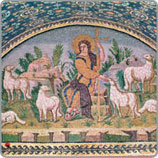
In the mosaic, the shepherd represents Jesus. He is dressed in a gold and purple, Roman-styled robe. He is youthful and clean shaven (contrasting with later images of a bearded Jesus), and his shepherd’s staff is in the form of a cross. The gold halo and cross signify Jesus’ divinity. The sheep represent the growing flock of Christians.
Jesus’ posture is also significant. In the image, he is shown reaching out to the left, which symbolized the East, the Church centered in Antioch. At the same time, his eyes are directed to the right, which symbolized the West, the Church centered in Jerusalem. The two centers of Christianity had been at odds over important theological issues. The artist shows that in Jesus, there is no division between East and West. The whole Church is one body in Christ.
The San Damiano Cross (circa 1100)
The San Damiano Cross is a large wooden cross that hangs in Santa Chiara Church in Assisi, Italy. The cross, which was originally in San Damiano Church, figured prominently in the life of Saint Francis of Assisi. While praying before the cross one day, Francis heard God speak to him. God called Francis to rebuild his church. At first Francis thought he was supposed to rebuild the crumbling San Damiano Church. He later realized that God was calling him to commit his whole life to renewing and rebuilding the Church of God.
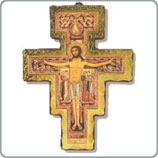
The San Damiano Cross is an icon cross painted in the tradition of the Eastern Church. The purpose of an icon cross is to help people understand or gain a deeper insight into the meaning of the cross. The San Damiano Cross does this through its depiction of Jesus Christ (who is represented as both wounded and strong), the major witnesses to the Crucifixion (Mary, the mother of Jesus; Saint John, the disciple whom Jesus loved; Mary Magdalene; Mary, the mother of James; and the centurion who proclaimed, “Truly this is the Son of God”), and the minor witnesses. The cross includes additional images, each of which provides insight into the meaning of the cross.
For a more detailed explanation, see the Web site of the Friars of the Third Order Regular
of St. Francis of Penance (Hollidaysburg, Pennsylvania) at
www.franciscanfriarstor.com
The Holy Resurrection (2000)
Nana Quparadze
Icon painter Nana Quparadze was born in 1976 and raised in the Republic of Georgia, where she studied icon painting. She then moved to Singapore and now lives in Denmark.
The Holy Resurrection was painted or written according to the ancient tradition of Orthodox Christian iconography, using egg yolk and natural pigment colors. The icon’s style is distinctly Georgian. Quparadze, like other iconographers, prepared for her work with prayer and fasting.
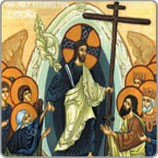
The icon was written in 2000 for the Holy Resurrection Orthodox parish in Singapore. It is particularly significant because it was written at a special time in history, when the Orthodox Church was officially established in Singapore.
In the icon, Christ is seen standing on the gates of hell, which he has shattered. He is pulling out of hell many of the righteous who had died before Jesus’ Resurrection. Christ preached to them when he descended into hell after his Crucifixion. This reflects the part of the Apostle’s Creed when we say, “He descended into hell.” This is the moment that Orthodox Christians traditionally portray in their icons of the Resurrection.
Adam and Eve are on the left, and Saint John the Baptist and kings David and Solomon are on the right. The risen Jesus is in white, which symbolizes that he is being portrayed post-Resurrection. (In images where Jesus is portrayed in his earthly ministry before the Resurrection, he is often shown in red, symbolizing his divinity, and with a blue cloak, symbolizing his humanity.) Christ is surrounded by the nimbus (the white oval with cherubic faces) which, in iconographic language, says that this event could not be seen by the human eye.
Resurrection (1996)
Solomon Raj
Color wood block print on rice paper
15 x 20 cm.
Dr. P. Solomon Raj was born in the West Godavary district of Andhra Pradesh, India. He is an artist and a Lutheran theologian. He uses batiks (a dyeing technique used on fabrics) and woodcuts for his art.
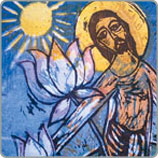
Raj created this image of Christ for a bishop of the Church of South India to accompany a pastoral letter at Easter. He made use of the message behind an ancient Hindu (Upanishadic) prayer to interpret the meaning of the Resurrection.
Lord lead me from Untruth into Truth
from darkness into Light
and from death into Life.
At the top of the image is the bright sun, and below it is the lotus blossom which is a symbol of the movement “from darkness into Light / and from death into Life.” The lotus moves from the dark clay at the foot of the water and rises into light toward the sun. This is the message of the Gospel. At the bottom of the image is the demon of death. Christ is shown rising triumphantly and trampling the demon of death, who is virtually under his feet. Raj borrows this symbolism from Hindu iconography, which often shows the god figures trampling miniature forms of the demon of death or the demon of darkness.
Wedding at Cana (1998)
He Qi is a professor at the Nanjing Union Theological Seminary and a tutor for master candidate students in the philosophy department of Nanjing University. He has been committed to the artistic creation of modern Chinese Christian Art since 1983. He hopes to help change the "foreign image" of Christianity in China by using artistic language, and at the same time, supplement Chinese art the way Buddhist art did in ancient times.
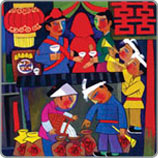
In his works, He Qi has blended together Chinese folk customs and traditional Chinese painting techniques with the western art of the Middle and Modern Ages, and has created an artistic style of color-on-paper painting.
For more information, see “Art Works of He Qi” at www.heqiarts.com.

